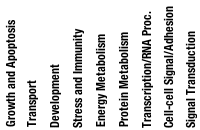Probes from L01D.profile.d50 that match DNA repair
| Results summary | View all lists in GO:BiolProc | View all genes in L01D.profile.d50 |
| Results summary | View all lists in GO:BiolProc | View all genes in L01D.profile.d50 |
|
The process of restoring DNA after damage. Genomes are subject to damage by chemical and physical agents in the environment (e.g. UV and ionizing radiations, chemical mutagens, fungal and bacterial toxins, etc.) and by free radicals or alkylating agents endogenously generated in metabolism. DNA is also damaged because of errors during its replication. A variety of different DNA repair pathways have been reported that include direct reversal, base excision repair, nucleotide excision repair, photoreactivation, bypass, double-strand break repair pathway, and mismatch repair pathway. enrichment: 3.73-fold |
 |
||||||||||||
| Probe ID | Name | G | T | D | X | E | P | R | C | S | Description | ||
| 219494_AT | RAD54B | X | R | RAD54 homolog B (S. cerevisiae) | |||||||||
| 214086_S_AT | PARP2 | X | P | poly (ADP-ribose) polymerase family, member 2 | |||||||||
| 218689_AT | FANCF | X | Fanconi anemia, complementation group F | ||||||||||